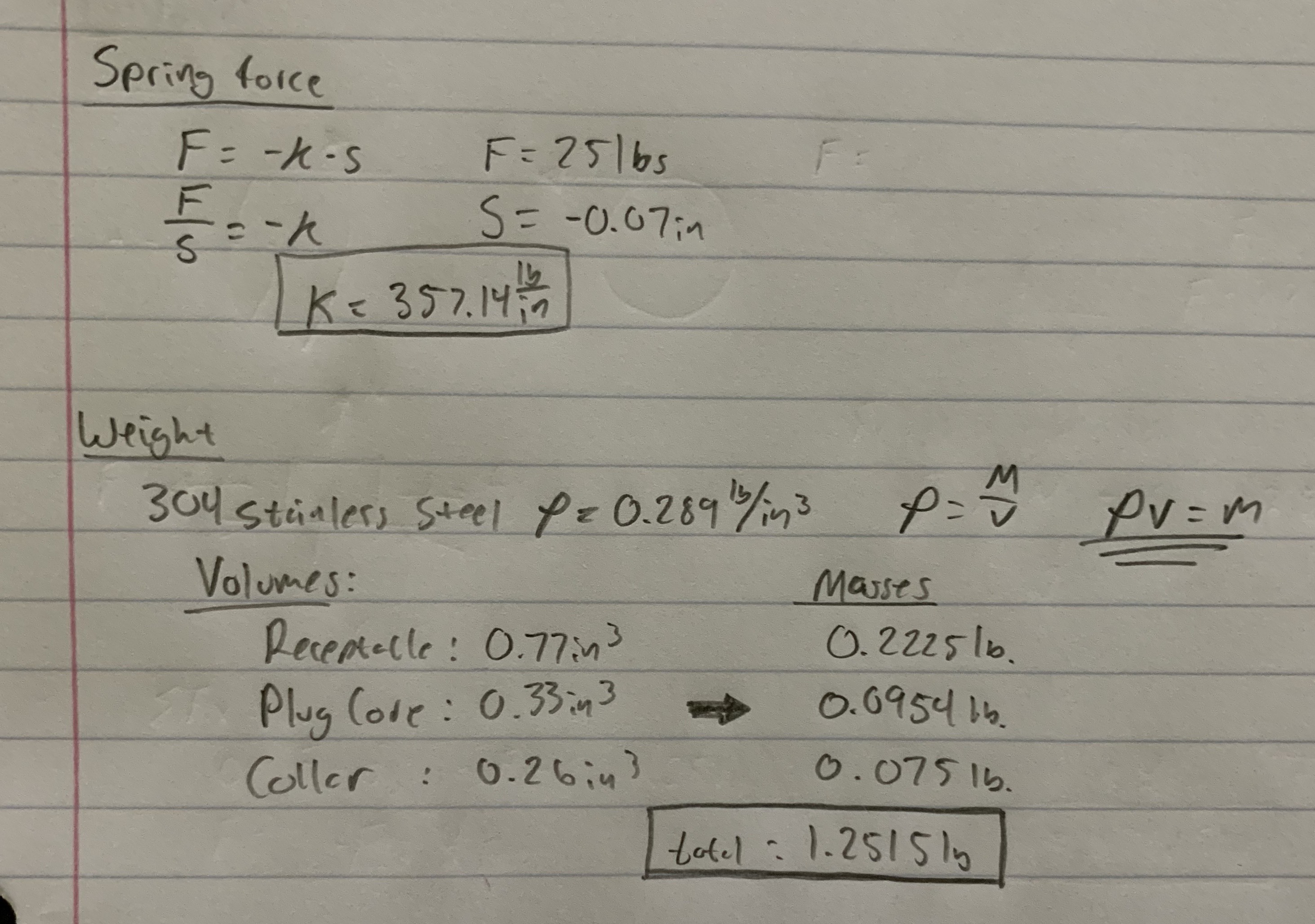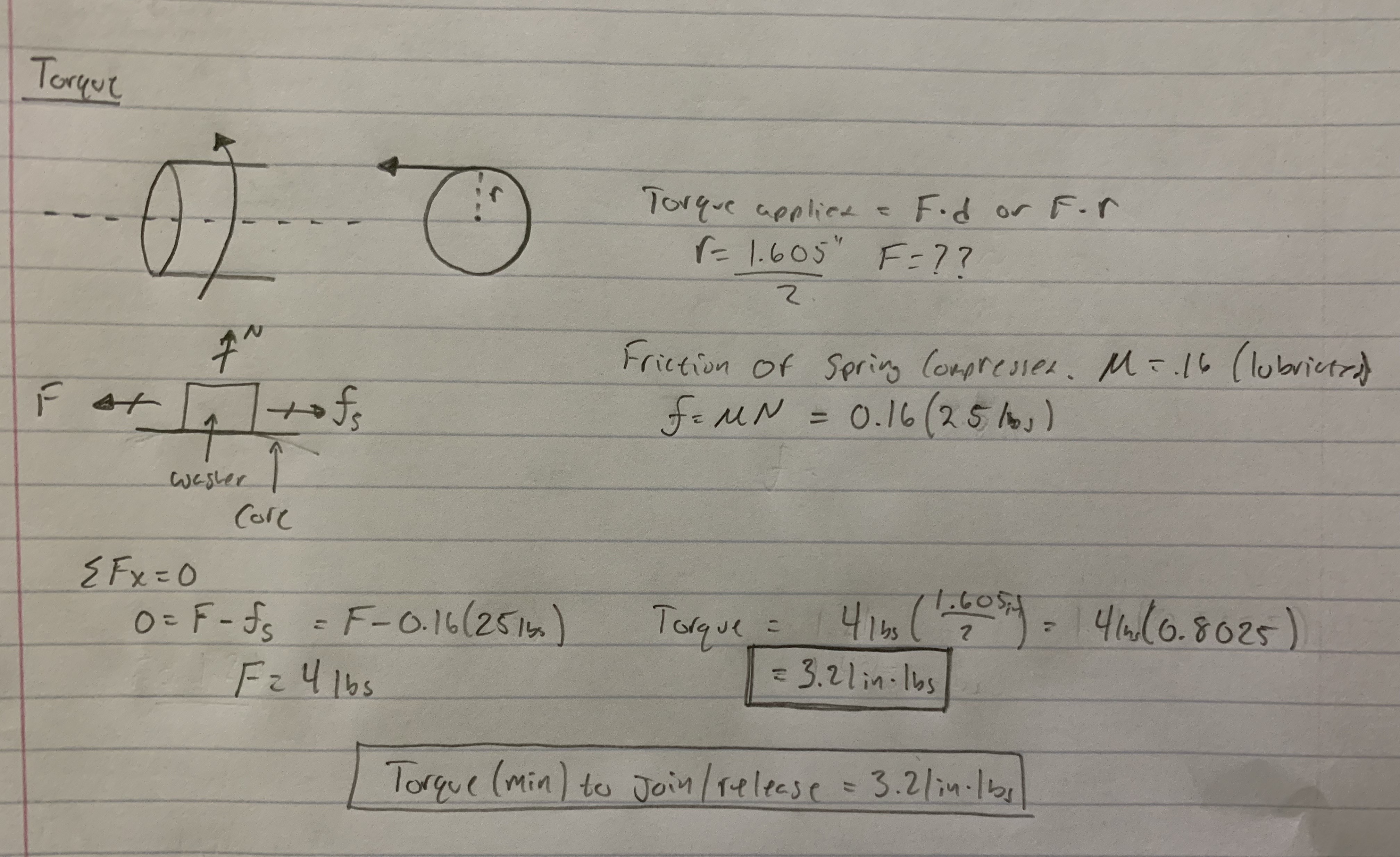Austin Northcutt
-Assignments-
_______________________
Assignment 2 | Assignment 3 | Assignment 4 | Assignment 5 | Assignment 6
_______________________
Assignment 5 - Components
Problem Statement:
The wiring harness for my engine needs to
be easily removed for service in the future. It also aids in
the process of removing the motor if I ever find the need
to. This device
needs to provide a way to quickly disconnect the 60 pin
wiring harness from the cabin of the car. This particular
design uses the force from an internal spring/wavy washer in
the assembly to lock the plug to the receptacle. There are many
problems that can arise from this. If the plug is not
inserted in a specific orientation the pins and
corresponding sockets will not be lined up correctly and
could cause damage.
Assumptions:
-Two main components: The Plug and the
Receptacle
-Assembly will see vibrations from the
car and engine
-The cannon plug can only attach in one
orientation with the use of guides.
-The plug will require 1/3 of a turn to
release from the receptacle.
-Will see a slight amount of
weathering/moisture.
-Friction between the plug collar, plug,
and the receptacle during mounting.
Gantt:
Decision Matrix:
-Based
off the results of the decision matrix, I will be going more
in depth into the module that incorporates a spring loaded
collar. The criteria I chose were all weighted on how
important they were to the main concept. The ranking
scale 1-5, 5 being the excellent, shows how well the
module holds up under the given criteria.
Components:
--Main
Assembly:
--Plug Assembly:
--Receptacle:
-The
receptacle
is mounted to the firewall of the engine bay and is static.
This houses all the pins for the interior side of the wiring
harness. There
will be a single guiding groove cut into the inner diameter
to ensure the plug can only attach one way. The three
guiding cylinders on the outside diameter will be grabbed by
the collar to guide the plug into place laterally.
--Plug Core:
-The plug core is main
portion of the plug assembly.
It houses the necessary pins on the engine side of the
harness that will be mated to the receptacle. The larger circular
rib extruded on the outer diameter serves as the spring seat
as well as the collar retainer.
--Plug
Collar:
The
collar
drives the locking mechanism in the main assembly. This is mounted on
the plug core and is able to rotate freely around the core. Guiding grooves
cut at an angle on the inside diameter of the plug. These
grooves serve as guides when the collar rotates around the
receptacle’s cylinders.
As the collar rotates around the receptacle, it will
draw the core in horizontally to mate to the receptacle. No rotation is
occurring from the core, only the collar.
--Wave
Washer:
A thin wavy washer serves as the spring force to keep the two halves mated together in the final assembly. It is sandwiched between the plugs core and the collar. As the collar is rotating about the receptacle it will laterally bring the core in and compress this spring. Once the guiding cylinders on the receptacle align with the holes on the collar, the spring will force the collar back, locking the assembly together.
Calculations:
-There were few calculations that were needed to be derived
but the main things that required them were the wave washer
given force, mass of the objects, and the torque required to
release and tighten the mechanism.
-The Wave washer spring rate was simply
found using Hooke's law, F = -ks.
-The mass of the objects were calculated
using P = m/v.
-The
torque required was found using dynamics. Friction constant of
polished steel on steel, normal force, spring force, were all
either givens or calculated.


Lessons Learned:
-How
to render in Solidworks.
-Material selection based off criteria is
now a very clear process.
-Material selection based of
elasticity/spring rate is now clear.
-How to pin motorsport connectors.
Began pinning my connector on the physical
harness.
Activity Log:
-4/9 (9am – 1:00pm) ::
Complete Decision matrix, update Gantt, and type up website
stuff in word
-4/9 (2:15 -
10pm) ::
Solidworks models and assemblies.
-4/10 (2:00 – 4:00) ::
Go in depth on formulas and decide on materials where
needed.
-4/10 (4:00 – 5:00) ::
Mock up website and make sure all images are working
-4/10 (7:00pm) ::
Submit Website
Comments:
William Hinson:
- Very organized assignment 5
flows well.
- My only complaint is there
is no final assembly. If someone who was not following
your portfolio were to look at your assignment, they wouldn't
know what it is.
James Neal:
- Great work, It was
cool seeing the motion study of the part.
- I like how in depth
you were with the material selection of 316 stainless.